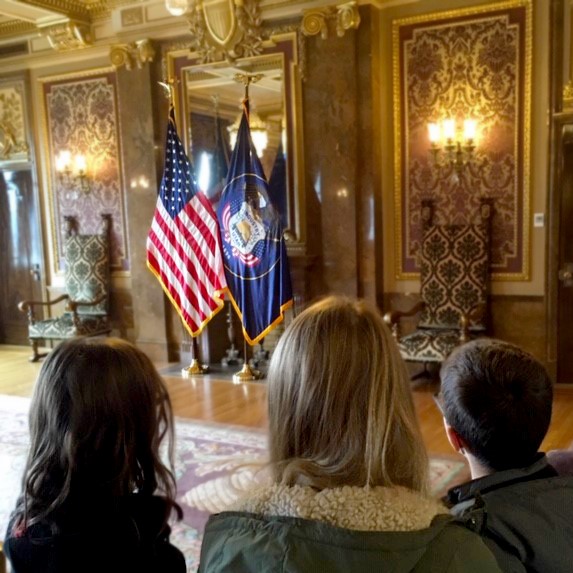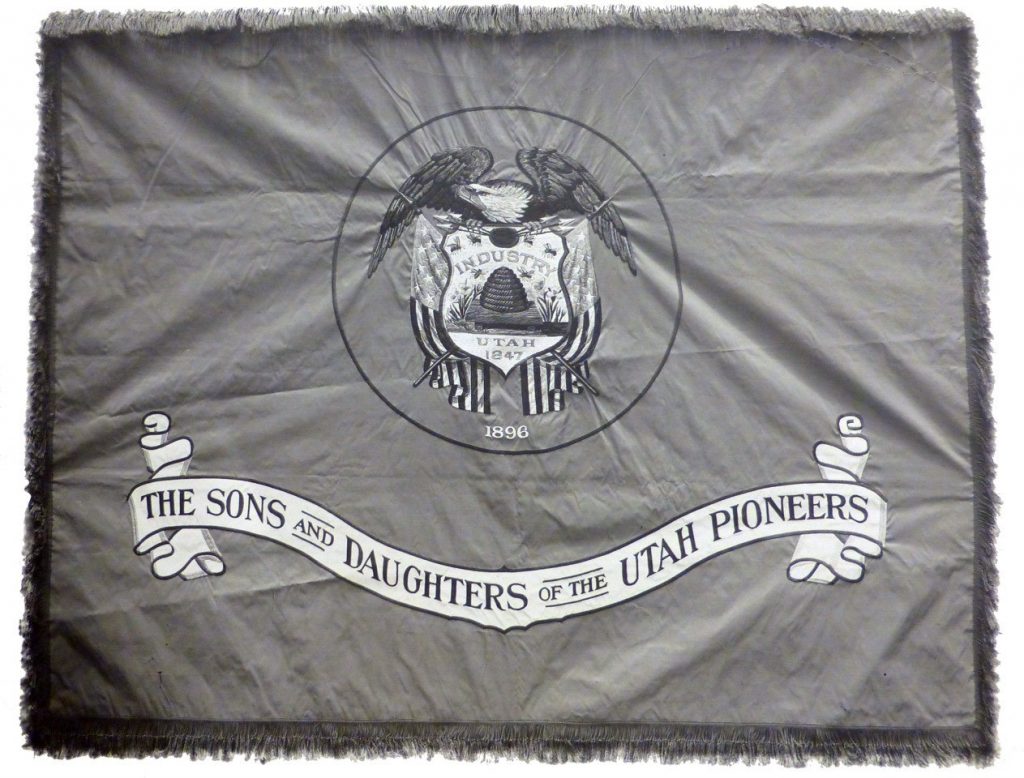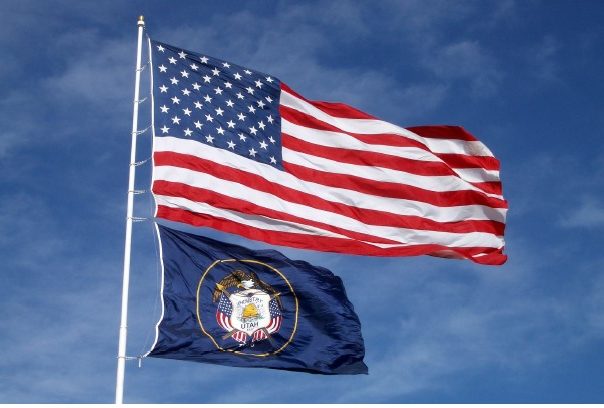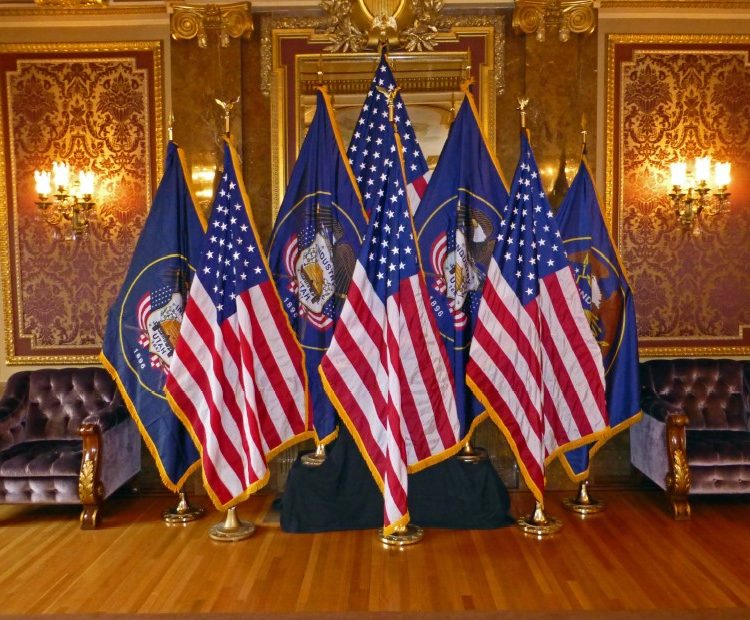It’s Utah State Flag Day
A Great Flag for a Great State
by John M. Hartvigsen
As students from Highland Park Elementary swarmed around exhibits at the Utah State Capital they experienced the grandeur of the building, its artwork and displays including the Utah State Flag. Displays including the State Flag seemed especially appropriate as Utah State Flag Day would follow their visit two days later on Saturday, March 9th.

Students from Mr. Lingen’s Fourth Grade Class view the striking display of the Utah State flag with the Stars & Stripes.
Utah is a great state, and it deserves a great state flag. The display of flags in the Capitol’s ceremonial chamber, the Gold Room, confirms that Utah has a great state flag, which matches the grandeur of its surroundings whether in the State Capitol or flying amid Utah’s magnificent mountains.
While the first flag to represent Utah as a state was not made until 1903, the historical roots of the Utah State Flag reach back to the beginnings of statehood itself. A state flag was not created in 1896, but the first legislature did authorize a flag for the new state’s military. It emblazoned the state seal on a blue background.

The first Utah State Flag was embroidered in 1903 and was displayed at the St. Louis World’s Fair in 1904.
In 1903, Governor Wells received invitations for the state to be part of a World’s Fair. It was important for the new state to present itself well. The governor perhaps remembered the military flag authorized by the Legislature in1896, and he ordered that a flag be produced for display at the Louisiana Purchase Exposition of 1904. This first version of the state flag spent that year displayed in the state’s pavilion, the flag was also carried to St. Louis in 1903, when the state’s fair delegation chose the site for the Utah State Pavilion. Visitors to the Utah Pavilion at the St. Louis Fair found the State Flag representing Utah.
The design of this first Utah State flag featured an emblem based on, but not exactly copying the design of the Utah State Seal. This continues to be true with the current Utah State Flag. The story of the flag then begins with the creation of the Utah State Seal when Utah became a state.

Harry Edward, a local artist, bank teller and bar tender made the first illustration of Utah’s State Seal in 1896. The motto INDUSTRY was added to the second illustration made shortly after.
Designed in 1896, “Great Seal of the State of Utah” provided the core emblem, which in 1903 became the central design of the first state flag. While some have criticized the use of the seal on the flag for following the example of many other state flags, students from Highland Park could easily recognize Utah’s flag displayed together with the Stars & Stripes in the Capitol’s magnificent Gold Room. Its impressive design portrays a dignity befitting a state flag.
The design for the seal expanded the design of Utah’s territorial seal composed of a skep beehive. Bees can nest in various places, but a skep is a dome shaped basket, and the Utah Territorial Seal place a skep on a shield. Located long distances from the East and West markets, early settlements in the Great Basin were like skep beehives, shelters constructed of native materials, where the colony could gather as they produced all their needs from their environment. The frontier environment required hard work and industry to establish Territory and State. Mark Twain visited these hardworking pioneers in 1861, and he commented on their choice of a beehive for a symbol. “[Utah’s crest] was simple, unostentatious, and fitted like a glove. It was a representation of a GOLDEN BEEHIVE, with all the bees at work.”
Creating a new seal for the state, the beehive would certainly be a central emblem. The committee placed the shield and beehive as part of a coat of arms with added symbols. While their understanding of heraldry was imperfect, they know what they wanted to symbolize, and it portrayed how they viewed themselves and how they wanted the world to see them.
On each side of the hive grow Sego Lilies, the state flower. A hardy flower that grows in dry climes, the petals of the flower twist beautifully with a strength not found in other blooms. They are part of the environment from which bees would gather nectar. Native tribes taught early pioneers to eat sego bulb when food was scarce. Just as the skep beehive symbolizes settlements founded by pioneers, the native flora represented by the Sego Lilly symbolizes the indigenous people that populated the area before the arrival of the later settlers.
Joining the state emblem—the Beehive, the State Insect—the Honey Bee, the State Flower—the Sego Lilly, the State motto—Industry found its placed above the skep. Perhaps the word could have been placed on a scroll below the shield, but the seal committee members wanted to give it prominence.
Two United States Flags were crossed behind the shield as heraldic supporters, and an American Bald Eagle took its place perched on the shield as a crest. Over half a century, Utah Territory shrank repeatedly as segments of land become parts of neighboring states; nevertheless, in 1896 Utah was finally admitted to the Union, and the citizens of the new state wanted to depict the fact clearly, Utah was finally a State.
The year Utah achieved Statehood and the year the pioneers arrived are two dates shown: 1847 on the bottom of the shield and 1896 below the shield. These years have particular meaning in Utah’s history. They describe a period known as the struggle for statehood. Three years after the arrival of the Mormon pioneers, they petitioned Congress for creation of a state to be called Deseret. Congress created instead the Territory of Utah in 1850, and repeated petitions for statehood were rejected over the second half of the 19th Century. This was because the Mormon settlers were an unpopular group because of their religion. Even in 1896, there existed religious prejudice, and some newspaper articles charged that the Mormons could not be trusted with a state government.
Often overlooked are symbols included to represent peoples living in the area which became Utah before the arrival of American pioneers. The top of the shield is pierced by six arrows, which symbolize six native tribes: Bannock, Shoshone, Ute, Goshute, Piute and Navajo. These peoples inhabited the area for centuries before the arrival of European explorers, traders and settlers. Further, the name Utah is not only the name of the state, but recognizes the Ute tribe, which was also called the Utah Tribe in the 19th Century. Congress, no doubt, chose the territory’s name to recognize the Utah or Ute tribe.

A black and white photograph of the flag presented to the Battleship USS Utah shows us what the image of the first full-color version of the Utah State Flag, upon which the current state flag is patterned.
With preparations for the launching of a battleship named in honor of the state, officials laid plans to present a “stand” of three flags to the USS Utah made up of (1) a National Color, (2) a Naval Infantry Battalion Color and (3) a Utah State Flag. The first two flags were not meant to fly in the ship’s rigging, but to be carried by the ship’s crew when standing in formation or forming a landing party. The Utah State Flag was not intended to be flown from the rigging or to be carried by the crew. Rather it was a hand embroidered work of art that was framed in a custom frame and bolted to the bulk head in the ship’s officers’ mess. The Officers’ Mess was not a mere dining hall reserved for officers, but the ship’s most impressive compartment used for imposing gatherings and ceremonies. The framed Utah State Flag displayed in that space created a majestic backdrop for the most majestic occasions.
The flag presented to the USS Utah was the first full-color version, and its design and colors were added to the Utah State Code. Unfortunately, the flag presented to the USS Utah was the only official state flag in existence for many years, and a copy of the flag made in 1922 failed to copy the colors or other details correctly. The color of the shield was changed from white to blue, which hurt the flag’s appearance, and this was corrected by a Utah Legislative action in 2011.

The U.S. and Utah State Flags make an impressive backdrop for Governor Herbert as he addresses an important issue.
The Utah State Flag does not merely symbolize the State’s history, it has been and is an essential part of Utah’s history.
Celebrate and fly the Utah State Flag on its special day.


